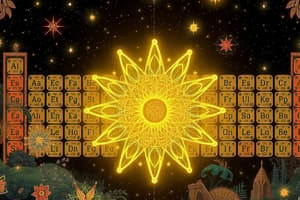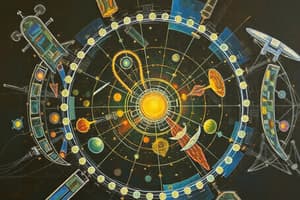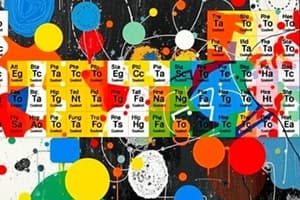Podcast
Questions and Answers
What determines the identity of an element?
What determines the identity of an element?
- The number of electrons orbiting the nucleus
- The number of protons in the nucleus (correct)
- The number of neutrons in the nucleus
- The mass number of the atom
If an atom of a certain element has an atomic number of 12, and a mass number of 24, how many neutrons does it possess?
If an atom of a certain element has an atomic number of 12, and a mass number of 24, how many neutrons does it possess?
- 12 (correct)
- 36
- 0
- 24
Which of the following is an example of a chemical property?
Which of the following is an example of a chemical property?
- Density
- Color
- Boiling point
- Reactivity (correct)
Which of these is a key characteristic of mixtures?
Which of these is a key characteristic of mixtures?
Elements within the same group on the periodic table have similar:
Elements within the same group on the periodic table have similar:
Which of the following describes the characteristics of electrons?
Which of the following describes the characteristics of electrons?
If an atom is neutral, how are the number of electrons and protons related?
If an atom is neutral, how are the number of electrons and protons related?
Which of the following is an example of a pure substance?
Which of the following is an example of a pure substance?
What is the primary function of the subscripts in a chemical formula?
What is the primary function of the subscripts in a chemical formula?
Which group of elements is primarily located along the 'staircase' on the periodic table?
Which group of elements is primarily located along the 'staircase' on the periodic table?
A newly discovered element has been found. Which of the following is the correct order of steps for classifying it?
A newly discovered element has been found. Which of the following is the correct order of steps for classifying it?
How many hydrogen atoms are in a molecule of $C_6H_{12}O_6$?
How many hydrogen atoms are in a molecule of $C_6H_{12}O_6$?
From the following options, which is the correct formula to calculate volume using the GRASS method?
From the following options, which is the correct formula to calculate volume using the GRASS method?
Which of these elements is NOT a metalloid?
Which of these elements is NOT a metalloid?
What elements are present in the compound $H_2SO_4$?
What elements are present in the compound $H_2SO_4$?
What force primarily holds galaxies together?
What force primarily holds galaxies together?
Using the GRASS Method, what is the correct way to determine density?
Using the GRASS Method, what is the correct way to determine density?
Which type of galaxy is the Milky Way?
Which type of galaxy is the Milky Way?
What are the three main classifications of galaxies?
What are the three main classifications of galaxies?
What process can significantly alter the appearance and properties of galaxies?
What process can significantly alter the appearance and properties of galaxies?
Which of these is NOT a terrestrial planet?
Which of these is NOT a terrestrial planet?
Why is Mars called the 'Red Planet'?
Why is Mars called the 'Red Planet'?
What is the primary condition related to the Moon's phase for a lunar eclipse to occur?
What is the primary condition related to the Moon's phase for a lunar eclipse to occur?
What position does the Moon have to be in relative to Earth and the sun for a lunar eclipse to occur?
What position does the Moon have to be in relative to Earth and the sun for a lunar eclipse to occur?
What is the first step in drawing a Bohr-Rutherford diagram?
What is the first step in drawing a Bohr-Rutherford diagram?
When two materials are rubbed together, what causes them to develop opposite electrical charges?
When two materials are rubbed together, what causes them to develop opposite electrical charges?
Which of the following best describes the lithosphere?
Which of the following best describes the lithosphere?
According to the electrostatic series, which of these is true about materials higher up in the series?
According to the electrostatic series, which of these is true about materials higher up in the series?
What is the primary distinction between autotrophs and heterotrophs?
What is the primary distinction between autotrophs and heterotrophs?
Which of the following is NOT considered an abiotic factor in an ecosystem?
Which of the following is NOT considered an abiotic factor in an ecosystem?
Which of the following properties can be used to help identify an unknown element?
Which of the following properties can be used to help identify an unknown element?
Which of these human actions poses a significant threat to ecosystem sustainability?
Which of these human actions poses a significant threat to ecosystem sustainability?
Which of the following is a property of noble gases?
Which of the following is a property of noble gases?
Which practice does not promote the sustainability of Earth's ecosystems?
Which practice does not promote the sustainability of Earth's ecosystems?
What makes noble gases resistant to forming ions?
What makes noble gases resistant to forming ions?
Which of these is NOT a property of halogens?
Which of these is NOT a property of halogens?
In a typical food chain, what role do primary consumers fulfill?
In a typical food chain, what role do primary consumers fulfill?
Which group of elements has low boiling points due to weak intermolecular forces?
Which group of elements has low boiling points due to weak intermolecular forces?
What is the result of cellular respiration?
What is the result of cellular respiration?
What is the most likely consequence of the introduction of an invasive species into an ecosystem?
What is the most likely consequence of the introduction of an invasive species into an ecosystem?
What is the overall equation for cellular respiration?
What is the overall equation for cellular respiration?
Which of the following is NOT a main process involved in the water cycle?
Which of the following is NOT a main process involved in the water cycle?
What primarily makes up the Earth's atmosphere?
What primarily makes up the Earth's atmosphere?
Which layer of the atmosphere is closest to the Earth's surface?
Which layer of the atmosphere is closest to the Earth's surface?
How do human activities contribute to climate change?
How do human activities contribute to climate change?
What does the Hertzsprung-Russell diagram represent?
What does the Hertzsprung-Russell diagram represent?
What is a primary role of food chains and food webs in an ecosystem?
What is a primary role of food chains and food webs in an ecosystem?
What process helps maintain the Earth's temperature through atmospheric gases?
What process helps maintain the Earth's temperature through atmospheric gases?
Flashcards
What are protons?
What are protons?
The positively charged particles found within the nucleus of an atom.
What are neutrons?
What are neutrons?
The neutral particles found within the nucleus of an atom.
What are electrons?
What are electrons?
Negatively charged particles that orbit the nucleus of an atom.
What is the nucleus?
What is the nucleus?
Signup and view all the flashcards
How does the number of protons determine an element?
How does the number of protons determine an element?
Signup and view all the flashcards
What are isotopes?
What are isotopes?
Signup and view all the flashcards
What are chemical properties?
What are chemical properties?
Signup and view all the flashcards
What are physical properties?
What are physical properties?
Signup and view all the flashcards
Periodic Table Classification
Periodic Table Classification
Signup and view all the flashcards
Metalloids
Metalloids
Signup and view all the flashcards
Atomic Number
Atomic Number
Signup and view all the flashcards
Mass Number
Mass Number
Signup and view all the flashcards
Electron Configuration
Electron Configuration
Signup and view all the flashcards
Valence Electrons
Valence Electrons
Signup and view all the flashcards
GRASS Method
GRASS Method
Signup and view all the flashcards
Bohr-Rutherford Diagrams
Bohr-Rutherford Diagrams
Signup and view all the flashcards
What is the lithosphere?
What is the lithosphere?
Signup and view all the flashcards
What is plate tectonics?
What is plate tectonics?
Signup and view all the flashcards
What are autotrophs?
What are autotrophs?
Signup and view all the flashcards
What are heterotrophs?
What are heterotrophs?
Signup and view all the flashcards
What are threats to the ecosystem?
What are threats to the ecosystem?
Signup and view all the flashcards
What are sustainable practices?
What are sustainable practices?
Signup and view all the flashcards
What is energy flow in an ecosystem?
What is energy flow in an ecosystem?
Signup and view all the flashcards
What is cellular respiration?
What is cellular respiration?
Signup and view all the flashcards
Electrostatic Series
Electrostatic Series
Signup and view all the flashcards
Electrostatic Series: Higher Materials
Electrostatic Series: Higher Materials
Signup and view all the flashcards
Electrostatic Series: Lower Materials
Electrostatic Series: Lower Materials
Signup and view all the flashcards
Noble Gases
Noble Gases
Signup and view all the flashcards
Halogens
Halogens
Signup and view all the flashcards
What is a galaxy?
What is a galaxy?
Signup and view all the flashcards
What is the Milky Way?
What is the Milky Way?
Signup and view all the flashcards
What are the three main types of galaxies?
What are the three main types of galaxies?
Signup and view all the flashcards
What is galaxy interaction and merging?
What is galaxy interaction and merging?
Signup and view all the flashcards
What are terrestrial planets?
What are terrestrial planets?
Signup and view all the flashcards
What is a lunar eclipse?
What is a lunar eclipse?
Signup and view all the flashcards
What conditions are needed for a lunar eclipse?
What conditions are needed for a lunar eclipse?
Signup and view all the flashcards
What causes a lunar eclipse?
What causes a lunar eclipse?
Signup and view all the flashcards
Cellular Respiration
Cellular Respiration
Signup and view all the flashcards
Water Cycle
Water Cycle
Signup and view all the flashcards
Earth's Atmosphere
Earth's Atmosphere
Signup and view all the flashcards
Greenhouse Effect
Greenhouse Effect
Signup and view all the flashcards
Hertzsprung-Russell (H-R) Diagram
Hertzsprung-Russell (H-R) Diagram
Signup and view all the flashcards
Food Web
Food Web
Signup and view all the flashcards
Food Chain
Food Chain
Signup and view all the flashcards
Producers
Producers
Signup and view all the flashcards
Study Notes
Chemistry Review
-
An atom consists of a nucleus and electrons orbiting the nucleus
-
The nucleus contains protons (positive charge) and neutrons (no charge).
-
Electrons have a negative charge.
-
Protons determine the element.
-
Neutrons can vary, creating isotopes.
-
Electrons typically equal the number of protons in a neutral atom.
-
Protons = Atomic Number
-
Neutrons = Mass Number - Atomic Number
-
Electrons = Atomic Number (neutral atom)
Chemical vs. Physical Properties
- Chemical properties describe how a substance interacts with other substances and changes its composition (e.g., reactivity, flammability, pH, solubility)
- Physical properties describe observable characteristics of a substance (e.g., state, color, density, melting/boiling point)
Pure Substances vs. Mixtures
- Pure substances consist of a single type of atom or molecule and have a fixed composition (e.g., O2, NaCl).
- Mixtures consist of two or more pure substances and have a variable composition (e.g., air, seawater, alloys).
Elements in the Same Group (Periodic Table)
- Elements in the same group (vertical column) share similar electron configurations and chemical properties (e.g., reactivity).
- This is because they have the same number of valence electrons, which are involved in chemical bonding.
Classifying a Newly Discovered Element
- Determine the element's atomic number and mass number.
- Identify the element's electron configuration and valence electrons.
- Compare the element's properties to those of other elements in the same group and period.
- Assign the element to the appropriate group and period.
Metalloids
- Metalloids exhibit properties of both metals and nonmetals.
- Located along the "staircase" on the periodic table (e.g., Silicon (Si), Germanium (Ge), Arsenic (As), Antimony (Sb), Tellurium (Te)).
Counting Atoms in Compounds
- Subscripts after element symbols indicate the number of atoms for each element (e.g., H₂O - two hydrogen atoms, one oxygen atom).
Identifying Elements in Chemical Compounds
- Identify elements by their symbols in the compound's formula (e.g., NaCl - sodium and chlorine).
Calculating Density
- Density = Mass/Volume (D = M/V)
- Rearrange to calculate mass or volume.
- Gather mass and volume data and record their units.
- Apply the density formula and simplify units.
- Report the final density value with correct units.
Bohr-Rutherford Diagrams
- Visual representations of atomic structure.
- Show the arrangement of electrons around the nucleus.
- Determine the atomic number.
- Draw the nucleus with the appropriate number of protons.
- Electrons are arranged in shells, beginning with the innermost first.
- Label shells and electrons in those shells.
Electrostatic Series
- Ranks materials based on their tendency to gain or lose electrons when rubbed together.
- Materials higher in the series tend to lose electrons and become positively charged.
- Materials lower in the series tend to gain electrons and become negatively charged.
Identifying Elements Based on Properties
- Use the periodic table and atomic number, mass number, electron configuration, and chemical/physical properties to identify an element.
Properties of a Noble Gas
- Extremely stable and unreactive.
- Colorless, odorless, and tasteless.
- Have full valence electron shells.
- High ionization energies.
- Low boiling and melting points.
Properties of a Halogen
- Highly reactive non-metals.
- Exist as diatomic molecules (e.g., F₂, Cl₂).
- Have high electronegativity.
- Form ionic bonds with metals to create salts (e.g., NaCl).
- Wide range of oxidation states (from -1 to +7).
- Low melting and boiling points.
Parallel Circuits
- Components connected to the same voltage source in multiple paths.
- Current in each branch is independent of the current in other branches.
- Total current is the sum of the currents in each branch.
- Voltage across each component is the same.
- Advantages: Components can be added or removed without affecting the rest of the circuit, components can operate independently.
- Disadvantages: More complex to design and build, requires more wiring and components, total current in the circuit can be high.
Simple (Series) Circuits
- Components connected end to end in a single path.
- Current is the same through each component.
- Total voltage is the sum of the voltages across each component.
- Advantages: simpler to design and build, requires less wiring, total current is lower.
- Disadvantages: If one component fails, the entire circuit stops working; components must be added or removed carefully, voltage across each component can vary.
Calculating Current and Voltage (Parallel vs. Simple)
- Parallel Circuits: Total Current = Sum of branch currents.
- Series Circuits: Total Current = Same in all components.
- Parallel Circuits: Voltage = Same across each component.
- Series Circuits: Total Voltage = Sum of voltages across each component.
Coulomb's Law
- The force between two charges is proportional to the product of the charges and inversely proportional to the square of the distance between them.
Hydroelectricity
- Renewable energy source using flowing water to generate electricity.
- Advantages: renewable, reliable, low operating costs, no greenhouse gas emissions.
- Disadvantages: requires specific locations, can have environmental impacts on local ecosystems, high initial costs.
Resistance
- Resistance is affected by length, cross-sectional area, and material of the wire.
- Longer wires have higher resistance, thicker wires have lower resistance, different materials have different resistivities.
Non-Renewable Resources
- Natural resources not replenished at the same rate they are consumed (e.g., fossil fuels, minerals, metals).
- Use can have significant environmental impacts.
Photosynthesis
- Plants convert light energy into chemical energy (glucose).
- Occurs in chloroplasts.
- Overall equation: 6CO₂ + 6H₂O → C₆H₁₂O₆ + 6O₂
- Involves light-dependent and light-independent reactions.
- Main source of oxygen in the atmosphere.
Earth's Spheres
- Biosphere: part of Earth inhabited by living organisms.
- Atmosphere: layer of gases around Earth.
- Hydrosphere: all water on, under, and above Earth's surface.
- Lithosphere: Earth's solid, outermost shell.
Ecosystem Factors
- Biotic: living organisms (producers, consumers, decomposers).
- Abiotic: non-living factors (e.g., sunlight, water, temperature).
Energy Flow/Trophic Levels
- Energy flows through ecosystem via food chains and webs.
- Trophic levels: producers, primary consumers, secondary consumers, tertiary consumers, decomposers.
- Energy decreases with each transfer.
Cellular Respiration
- Organisms convert chemical energy (glucose) into ATP.
- Occurs in mitochondria.
- Reverse of photosynthesis.
- Overall equation: C₆H₁₂O₆ + 6O₂ → 6CO₂ + 6H₂O + ATP.
Studying That Suits You
Use AI to generate personalized quizzes and flashcards to suit your learning preferences.




